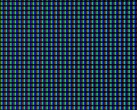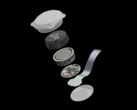Humans normally detect light between 400 nm and 700 nm. A team led by Yuqian Ma has now extended that range by developing soft contact lenses that convert near-infrared (NIR) photons into visible light, giving wearers direct NIR vision without surgery.
The lenses embed upconversion nanoparticles in a poly-HEMA matrix. By matching the refractive index of the polymer to the particles and keeping the nanoparticle load at seven percent by mass, the authors maintained more than 85 percent transparency across the visible spectrum. Mechanical tests showed flexibility and fatigue resistance comparable to commercial lenses, and six-hour ocular safety trials in mice revealed no added corneal apoptosis or retinal inflammation.
Electroretinography recorded normal visible-light responses plus clear NIR responses only when lenses were present. Mice wearing the lenses constricted their pupils under 980 nm illumination, avoided an NIR-lit chamber, and used NIR flicker to escape shock. These effects persisted with sutured eyelids, consistent with an eyelid transmittance of 23 percent at 980 nm versus 0.4 percent at 535 nm.
Human volunteers showed similar results. Lens wearers detected NIR flashes in darkness and under 300 lux ambient light; closing the eyes scarcely impaired NIR sensitivity but suppressed visible-light sensitivity by two orders of magnitude. Their NIR flicker-fusion threshold matched the visible benchmark, and they decoded Morse-style sequences as accurately as with visible light. An external three-lens eyeglass module projected NIR scenes through a flat up-conversion film, yielding a spatial-resolution limit near 65 cycles per degree and enabling recognition of simple NIR line, letter, and shape patterns.
Replacing the conventional nanoparticles with a trichromatic, orthogonally excited design added color. Separate 808 nm, 980 nm, and 1532 nm excitations produced isolated green, blue, and red emissions, respectively. Color-matching trials showed that users could mix these three “primary” NIR channels to reproduce the full NTSC-sized chromaticity gamut and distinguish multicolor symbols, sentences encoded by combined color-and-temporal cues, and reflective objects whose NIR hues differ from their visible appearance.
Bear in mind that lenses remain years away—issues like low sensitivity without active NIR illumination, inherent resolution limits, color-constancy challenges and the need for broader human testing must be solved. Smart glasses with NIR cameras and displays could reach consumers in a few years, whereas upconverting contact lenses will likely need many more years of materials, optics and regulatory work.
Source(s)
Cell (in English)


























